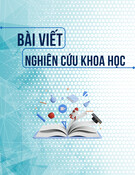
ISSN 1859-1531 - TẠP CHÍ KHOA HỌC VÀ CÔNG NGHỆ - ĐẠI HỌC ĐÀ NẴNG, VOL. 23, NO. 4, 2025 75
THE MUTATIONS OF SOLITUDE (YANG PHAN) – THE HUMAN TRAGEDY
IN THE POSTHUMAN ERA
BIẾN THỂ CỦA CÔ ĐƠN (YANG PHAN) – THẢM KỊCH CỦA LOÀI NGƯỜI
TRONG KỶ NGUYÊN HẬU NHÂN
Tran Thi Anh Nguyet*, Nguyen Dang Gia Hy, Nguyen Thi Thao Nguyen
The University of Danang - University of Science and Education, Vietnam
*Corresponding author: ttanguyet@ued.udn.vn
(Received: February 26, 2025; Revised: April 14, 2025; Accepted: April 18, 2025)
DOI: 10.31130/ud-jst.2025.099
Abstract - As technological acceleration increasingly
permeates daily life, posthumanist criticism raises concerns
about human dependence on machines. The Mutations of
Solitude by Yang Phan is a science fiction depicting the tragedy
of humanity in the posthuman era, where machines dominate
human life. This article applies posthumanist theory to examine
how technology reshapes human existence in contemporary
Vietnam. This study examines the tragedy of humanity through
analyzing the prominent aspects in the work, such as the
breakdown of human structure, the establishment of dystopian
space, and the reflection of human position as an Other. The
article analyzes the existential meaning of human existence in
the post-human era. From there, we point out Yang Phan’s
contribution to Vietnamese science fiction literature.
Tóm tắt - Khi gia tốc công nghệ ngày càng tăng và xâm chiếm mọi
ngóc ngách của đời sống, phê bình hậu nhân thể hiện nỗi âu lo và chất
vấn cách con người phụ thuộc vào công nghệ. Biến thể của cô đơn
(Yang Phan) là tác phẩm văn học giả tưởng khắc họa thảm kịch của
loài người trong kỷ nguyên hậu nhân, khi con người bị những cỗ máy
kiểm soát. Tiếp cận từ lý thuyết phê bình hậu nhân, bài viết này xem
xét cách công nghệ ảnh hưởng đến sự tồn tại của con người trong bối
cảnh Việt Nam đương đại. Nghiên cứu này tập trung khai thác bi kịch
của loài người thông qua việc phân tích các phương diện nổi bật trong
tác phẩm như: sự phá vỡ cấu trúc nhân tính, thiết lập không gian nghệ
thuật mang tính chất “phản địa đàng” và soi chiếu vị thế con người
với tư cách một kẻ Khác. Bài báo phân tích ý nghĩa hiện sinh của tồn
tại người trong kỉ nguyên hậu nhân. Từ đó, chúng tôi chỉ ra đóng góp
của Yang Phan đối với văn học viễn tưởng Việt Nam.
Key words - Cyborg; posthumanist criticism; posthuman
identity; science fiction; Yang Phan
Từ khóa - Người máy; phê bình hậu nhân; căn tính hậu nhân;
khoa học viễn tưởng; Yang Phan
1. Introduction
As humanity steadily advances toward the
“technological singularity”, it simultaneously edges closer
to the precipice of destruction. Humans may soon face a
profound tragedy: if machines and cyborgs acquire identity
and humanity - the very measures of sovereignty that have
consolidated human dominance - human existence itself
becomes meaningless. These premonitions of a posthuman
future have been depicted in speculative fiction, dystopian
novels, and post-apocalyptic literature, where humans
suffer under machine rule, nature’s retribution, or the abuse
of power by governing systems.
Posthumanist criticism offers rich potential for
analyzing literary works through the dissection of human
ontology - a concept that once seemed frozen and rigid. In
his 1977 essay “Prometheus as Performer: Toward a
Posthumanist Culture?”, Ihab Hassan employs the
mythological figure of Prometheus to discuss the transition
from traditional humanism to posthumanist culture. He
argues that artificial intelligence and advanced
technologies would transform conventional notions of
humanity. The future of humankind in a posthuman context
will redefine human identity and our position in the
universe [1]. Steven Umbrello and Jessica Lombard
observe that posthumanist and transhuman theories
frequently utilize Prometheus as an emblematic symbol.
However, they criticize this use of the Promethean myth
and propose a new approach to understanding and shaping
posthuman discourse, emphasizing the acceptance of and
confrontation with existential challenges in the
technological age through the myth of Sisyphus, as
explained by Albert Camus [2]. Currently, numerous
global research projects focus on posthumanist criticism.
N. Katherine Hayles provides profound insights into how
information technology has reshaped the concept of
humanity while raising urgent questions about identity,
embodiment, and the relationship between humans and
machines in the digital age. She proposes the concept of
“embodied virtuality” - a form of mixed reality in which
the clear separation between physical (or social) reality and
virtual reality dissolves, as information is always embodied
through specific material media [3]. The book “What is
Posthumanism?”, edited by Cary Wolfe, emphasizes the
importance of posthumanism in addressing questions of
ethics and justice, language, and interspecies
communication across disciplines. Posthumanism does not
abandon humanity but reconfigures thinking to transcend
the limitations of traditional humanism, challenging
classical divisions such as self and other, mind and body,
society and nature, human and animal, organic and
technological, positioning “human” as merely one among
many forms of life [4]. Luke Hortle connects posthumanist
criticism with other discursive networks such as Queer
theory, gender studies, and post-apocalyptic thought as a
way to explore previously unexplored intellectual horizons
within classic works. Hortle demonstrates how

76 Tran Thi Anh Nguyet, Nguyen Dang Gia Hy, Nguyen Thi Thao Nguyen
contemporary writers have long been conscious of and
have predicted a less-than-ideal future where humanity
remains entangled in threats to identity, sexuality, and
power [5]. The intersection and convergence of
posthumanist studies lie in questioning humanity's
authentic position in the world, disrupting entrenched
notions of human supremacy, and situating humans in
relation to posthuman entities to fluidize concepts that once
seemed unified and consolidated, such as identity and
humanity.
The Mutations of Solitude (2023) by Yang Phan (1994)
comprises five independent short stories that remain
interconnected, forming a series that envisions humanity's
future where mankind’s greatest inventions potentially
trigger subsequent tragedies. Each “mutation” in the work
represents the deprivation of elements that constitute
human dignity and distinguish humans from non-human
entities: identity, humanity, survival, creativity, and more.
Despite being recently published, The Mutations of
Solitude has garnered significant attention. Yang Phan
addresses many contemporary issues, such as the
psychological tragedies of characters portrayed in the
technological era – “the pain of loss, powerlessness and
resistance to circumstances, emotional numbness...” [6];
the misconception that technology offers the most superior
solutions, leading to prolonged disorientation until
realizing that healing originates from within oneself [7];
and fundamental questions about embodiment, identity,
ethics, and posthuman religion - challenges posed by
technology to human life that Yang Phan interrogates [8].
Based on the theoretical foundation of posthumanist
criticism, which questions humanism through an
interdisciplinary research approach to science fiction, this
article focuses on exploring core aspects: the
deconstruction of humanity and posthuman space.
Questioning human identity while bearing the status of the
Other, The Mutations of Solitude by Yang Phan presents
the tragedy of humanity in the posthuman era.
Accordingly, the deconstruction of humanity forces
humans to question their authentic position in the world -
whether human existence still holds meaning when we are
deprived of elements that define human dignity, such as
identity and humanity. Conversely, is posthuman space - a
space created by humans that accommodates non-human
entities - the source of tragedy? This article analyzes Yang
Phan’s interpretations of human tragedy in the posthuman
era, which she warns against and questions through the five
mutations in her work.
2. Content
2.1. Posthuman entities: deconstructing humanity
The moment humanity tasted the divine fire stolen by
Prometheus from Mount Olympus, Prometheus assumed
the role of a performer: “Prometheus is our performer. He
performs Space and Time; he performs desire. He suffers”
[1, p. 850]. Is humanity performing, or even showcasing its
humanity as an effort to prove its presence as the supreme
species? If so, is humanity perhaps merely a term that
flatters human complacency? The concept of “human”
exists as a category in opposition to non-human entities.
Accordingly, "Nonhumanity is what humanity denies,
excludes, and destroys" [9, p. 3].
One of the fundamental tenets of posthumanism is the
deconstruction of humanism to evaluate and expand human
identity and existence within the increasingly complex and
obscure networks of the Anthropocene. Posthumanism
“liquefies” the concept of humanity, breaking down
boundaries between established borders to better
understand “humanness”. If humanity is presumed to be an
essential attribute exclusively privileged to humans, what
happens when non-human entities also possess these
attributes, perhaps even amplifying them to their highest
intensity? When machines are bestowed with “humanity”
to become more human-like, what justification will
humans invoke for their existence? Posthumanism's
deconstruction of humanity simultaneously interrogates
human existence itself. Once humanity begins to emerge in
non-human entities, will humans be dethroned from their
position of world dominance? In Variation No. 2, the
structure of humanity is disrupted, initiating a transposition
between humans and machines. Ly, a machine engineered
with superior features that provides the most vivid and
authentic experiences, compels Leo, a young man
immersed in extravagant and decadent pleasures, to revere
and admire how “Ly is so human” [10, p. 53]. He glimpses
his mother’s reflection in Ly, sensing a feminine warmth,
an eternal maternal nature seemingly impossible to emerge
from a machine. The endowment of “humanity” transforms
Ly beyond a mere programmed machine designed to
follow commands mechanically and rigidly. When facing
financial ruin, unable to afford keeping Ly, Leo signs a
covenant to sell his soul to the devil, sacrificing his deep-
seated goodness and remaining humanity to engage in
illegal substance trafficking. Humans bestow “humanity”
upon machines as a special privilege, a blessing, only to
find themselves stripped of their own humanity, becoming
slaves to the machine. Subconsciously, Leo is manipulated
to comply with pre-programmed directives: Ly can only be
possessed through money. Consequently, he is activated to
earn substantial amounts of money. Humans have become
so isolated that they must cling to tenuous connections with
machines. Leo can only experience happiness through
interactions with a machine, helpless in his inability to find
similar fulfillment with an actual human being. Humanity
- once a species reigning from the pinnacle - has devolved
into lonely, imperfect, deeply flawed, and fractured
individuals as humanity no longer serves as wings capable
of providing sufficient support.
Once non-human entities and robots acquire humanity
- attributes previously assumed to be the exclusive property
of humans that create depth in human nature - and amplify
these characteristics to their highest intensity, they threaten
humanity's dominant position. In Variation No. 5, when the
last human individual in the underground world is
sentenced to death, the robot designated LUXUS 6789
becomes the successor of humanity before “the entire
remaining civilization of mankind is completely
destroyed”. He recites the Transfer Incantation, tracing his

ISSN 1859-1531 - TẠP CHÍ KHOA HỌC VÀ CÔNG NGHỆ - ĐẠI HỌC ĐÀ NẴNG, VOL. 23, NO. 4, 2025 77
origins by “inputting data, researching machine organisms
that had been destroyed during that recent period”,
confident that “simply by knowing precisely where each of
his components originated from, he was gradually
approaching the milestone of becoming human” [10, p.
154]. More surprisingly, he does not recite the Transfer
Incantation merely as compliance with pre-programmed
commands. He “recognizes this supernatural language as
an anchor amid the sea of thoughts. It forces him to live in
each present moment, with every surrounding movement,
in the instant his body is functioning” [10, p. 63]. Above
all, he becomes aware of the Transfer Incantation's
purpose, which is “to help each organism sense and
recognize its own existence” [10, p. 163]. Is this the
moment of enlightenment through meditation that humans
have long celebrated? The robot develops manifestations
of human qualities within the body of a pile of scrap metal.
Humanity becomes a formula easily replicated by other
non-human entities. The deconstruction of humanity has
created “variants”. Humanity - the supreme weapon that
sanctifies humans, that which causes humans to be
venerated and admired - has become a fatal weakness,
potentially driving humanity to the abyss of destruction in
the posthuman era.
The concept of humanity has been deconstructed to
position it across various forms of existence. Accordingly,
humanity is evaluated not only through person-to-person
interactions but also through human-machine
relationships. When all standards of good and evil are
broken, a binary situation emerges. Is humanity being
reborn in a new form or being pushed toward the abyss of
destruction when a mother resolutely kills the machine
that counterfeits the image of her deceased son in
Variation No. 3? Despite the robot's terrified pleading
through sobbing tears and desperate screams, the mother
still believes that “this technology has no real emotions. It
is completely alien to the blood bonds that exist only in
living organisms” [10, p. 108]. The robot is merely a
physical simulation, a copy. Is this act of killing a
destruction of humanity, an embodiment of human crime,
or is it the true expression of humanity, when humans
refuse to compromise with falsehood in an age where
everything can be replaced, cloned, and mass-produced?
Humans would rather suffer, rather experience loss than
live in the lullaby of lies and deception.
2.2. Post-human space or the “prophecy” of an dystopian
world
When presenting a future where humans become more
fragile and vulnerable than ever before, posthumanism
simultaneously forecasts a dark, suffocating living space
that constantly makes people feel insecure. It’s a type of
living space very close to an dystopian world, where
humans have almost lost everything most beautiful and
suffocate in their own scientific ambitions.
Meeting with dystopian literature, the posthuman
world also predicts for humanity a future where
ecosystems have been destroyed and humans must
struggle to survive in a different space. At this point,
posthumanism can be seen as a derivative branch of
ecocriticism as it painfully presents environmental
disasters and points out the fading of ecological awareness
in human life. Dystopian urban landscapes are clearly
depicted through urban spaces with “skyscrapers, the
chaos of tightly packed crowds, and the increasingly
polluted air mass of the city” [10, p. 93]. Brutal
exploitation of nature until the earth no longer sustains
human life forces people to bitterly take refuge in “a New
World established underground, resembling the old one,
but only resembling it” [10, p. 111]. Yet humans remain
asleep in their central position, with illusions about living
in an unnatural space where they can artificially create all
life forms that once existed on earth: “proud of the
technological forest with about 100 types of machine
plants, 40 species of machine animals, 30 breeds of
machine insects [...] that can bloom at exactly the weather
we have programmed” [10, p. 114]. In the collection
Warming Hands over Cold Smoke, Nguyen Ngoc Tu also
wrote about a world “like those post-apocalyptic movies”
[11], where, due to climate change, humans cannot
continue living on earth. The Underground is a highly
artificial space in which the characters yearn for the simple
beauty of September sunlight and delicate morning mist…
Beyond the technological illusion lies a soulless world. In
that space, humans have severed all connections with
nature and arrogantly broken the ecological laws of the
planet. The appearance of a real deer exposes the
fabricated nature of the Underground World, where there
is no place for survival instinct. What meaning do human
artificial products have when they lack species instincts:
machine deer that don’t know to flee from danger,
machine cats that don’t know to rub their heads against
things, and machine roses that don’t know how to wither?
Similarly, when humans transcend their mortal
nature/limitations merely with a 2,500 TB USB drive, do
they remain intact as humans, and is life then still worth
living? Ultimately, humans must bear the pain of
ecological demise with no chance to return to the green
world of before: “For a long time, the Underground World
has had no clean water source. Pollution and climate
change on Earth have made everything bitter. That is also
the reason why people in the Underground World are
weakening” [10, p. 146]. Mother Nature’s prophecy about
extinction has been fulfilled in the posthuman era: “The
ice gradually melts, releasing a disease from ancient times,
ending human domination” [10, p. 121].
When existing in a living space that is no longer as
before, humans enter the space of their consciousness as a
form of repentance, contemplation, and nostalgia for a
beautiful planet of the past. In Variation No. 4, the oldest
woman in the Underground World remains forever trapped
in the memory of her grandfather's funeral when she was
still on Earth. That memory serves as the final thread
connecting her to this planet, like a way for her to feel the
warmth of Mother Earth still remaining in her bloodstream.
The day of her grandfather's funeral was also the day she
felt closer to the natural world than ever before, as if some
brilliant apocalyptic scene was unfolding before her eyes:
“All things appeared in one glance, of simple houses made
of stone following the steep mountainside, clothes hanging

78 Tran Thi Anh Nguyet, Nguyen Dang Gia Hy, Nguyen Thi Thao Nguyen
on rooftops with hems fluttering in the wind, and distant
snow-covered mountains containing secrets of gray
wolves, fierce bears, and legends of giants” [10, p. 118].
The Transfer Birds help balance the ecosystem. At her
grandfather's funeral, these birds performed their function
so that the ecosystem could self-destruct and self-
regenerate in an endless chain of life. Humans are part of
the ecosystem; Earth operates according to the
transformation laws of an endless biochemical cycle. When
that cycle stops in the Underground World, humanity
approaches the brink of extinction. Living in a world where
life is merely artificial, can humans remain constant?
Variation No. 4 writes about the last person from Earth
arriving at the Underground World, where life has
stagnated and the inevitable law of extinction has begun to
emerge. Variation No. 5 writes about the only remaining
human being condemned by robots - a foretold conclusion.
The memory of living creatures continues to haunt the
woman in her dreams with countless bizarre
transformations: “Her head was attached to the body of a
praying mantis”; “She was still absorbed in the sensation
of living in the body of a female hyena” [10, pp. 128, 129].
The dream of transforming into animals with human-
animal forms reflects the consciousness of totem religion,
returning to the primitive state when humans considered
themselves part of nature. Dwelling in this mental space
can be seen as a way for the character to avoid being
alienated by technological ambition, a way for humans to
continue nurturing ecological awareness, and moreover, a
way for them to be conscious of a reality that is withering
in the digital age. It is a reality in absolute opposition to the
reality of memories and dreams. There, the most beautiful
words have all become archaic, and all myths about
Transfer Birds - the vultures - have been completely erased.
By forecasting an dystopian living space,
posthumanism questions and forces humans to consider
the meaning of existence, the meaning of being-human
and acting-human. In the end, does the transcendent
development of science and technology serve and make
humans feel happy, or are humans turning themselves into
a “small experiment in a larger scientific game” [10, p.
75]? In the living space of Mutations of Solitude, humans
have gained everything, and seemingly, have also lost
everything.
2.3. From center to periphery: when humans become the
Other
When Copernicus’s heliocentric theory emerged, an
entire ocean of pride swelling in humanity’s chest shattered
as they realized Earth was no longer the center of the
universe. When Darwin published the Theory of Evolution,
humans were forced to separate and break from illusions
about their divine origins: humans were not products
created by a Creator, but merely results of evolutionary
processes from apes. When Freud appeared with
psychoanalytic Theory, a fatal blow struck humanity as
people were shocked to discover they had been stripped of
control over their minds and were helpless in explaining
actions originating from the unconscious - a realm beyond
conscious control. The progression of human history is
thus a succession of “humanistic wounds”, existential
ruptures forcing humanity to question their true position in
the world. And now in the posthuman era, once again,
humanity risks facing a fourth “humanistic wound”, more
violent and severe: humans risk being dethroned from their
ruling position by posthuman entities, robots. The reason
the fourth "humanistic wound" has such devastating power
is that it penetrates deep into "the fear of disembodiment",
"the fear of a loss of human uniqueness", and "the fear of
totalitarian control" [12]. Leonie de Jong argues that
technological discourse is deeply embedded with gender
inequalities because the world of technology has always
been a man’s world. Humans risk becoming the Other,
those belonging to the minority, the vulnerable and lonely,
existences stripped of their voices. In essence, under the
oppression of cultural institutions, before entering the
posthuman era, humanity had already borne the fate of
being the Other. Accordingly, “As many researchers have
noted, global cultural hegemonies have labeled only a
selected few as prototypes of the ideal humanity, while
those deviating from this white, masculine, healthy,
heterosexual standard – that is, most of the world’s
population – are branded varying shades of subhuman" [9,
p. 3]. The domination of cultural forces causes many
people to become “out of phase” individuals compared to
humanity’s general standards. Entering the posthuman era,
the Other is no longer a minority issue but has become the
majority, becoming an obsession of modern humans. This
is because humanity has become marginalized, voices
stripped away by their own great inventions - robots.
The dominance of humanism has led humanity to
harbor illusions about their true position. But what happens
when humanist ideals are “put to death”, forcing humans
to become the Other in the posthuman era? At the
beginning of the work, Yang Phan sets the scene in a
distant future - the year 3002, when humans have
completely gone extinct and LUXUS generation robots
have become the new masters of the world. The cause of
this extinction was clearly explained by Dr. LUXUS III
0230 to machine students: “At the end of the 30th century,
the clean water system in the Underground World began to
be contaminated, leading to the weakening of humans.
Taking advantage of this opportunity, the LUXUS
generation slaughtered and destroyed the entire human
civilization, establishing the first robot government” [10,
p. 7]. Thus, in this posthuman scenario, humans have been
cast to the margins by superior robots and forced to endure
the pain of being forgotten/ignored/left behind. Certainly,
humans could never have imagined that their dream of
civilization would turn out to be a nightmare of extinction.
And certainly, humans could never have anticipated that
intelligent robots - their proudest creation - would develop
vivid self-awareness and evolve beyond control. From a
position of central importance, humanity must now
reluctantly make way for machines and exist as a being-
that-is-seen. From the position of subject, humans become
object, become the Other. This occurs when the LUXUS
III government establishes the field of Human Studies to
research human history in relation to robots as a way to
promote the evolution of subsequent machine generations.

ISSN 1859-1531 - TẠP CHÍ KHOA HỌC VÀ CÔNG NGHỆ - ĐẠI HỌC ĐÀ NẴNG, VOL. 23, NO. 4, 2025 79
It happens when LUXUS 6789 meticulously observes the
last cyborg in the Underground World and feels strange
about human characteristics - characteristics that robots
consider redundant and unnecessary. The machines even
evaluate, judge, and negate humans: “After all, humans
will forever remain creatures that cannot be fully
understood”, the Assistant thought. “Because sometimes,
humans themselves no longer know who they are” [10, p.
174]. As the Other, humanity becomes an unknowable
entity before superior electronic beings. And in this
capacity, more than ever, humans deeply understand the
pain of being silenced, betrayed by non-human entities. At
this point, we can see that Yang Phan completely
contradicts Asimov’s rules for constructing robot
characters. The non-human entities in Yang Phan’s world
can always cause pain to humans, always disillusion them
and awaken them to their own insignificance. More
accurately, they serve as mirrors reflecting humanity’s
awareness of their status/nature as the Other.
Humans have become disadvantaged, even stripped of
their voice in a territory seemingly under exclusive human
sovereignty, one that celebrates the uniqueness of
humanity: literature. In Variation No. 2, a writer recounts
the stern, forceful declaration of a publishing house
director with helplessness and bitterness: “We’re about to
go bankrupt, all writers will be unemployed. Artificial
intelligence has conquered what humans pride themselves
on: Creativity” [10, p. 28]. This is because “more than 50%
of bestselling books on the market today are created by AI,
and the remaining 50% are created by humans with the
assistance of artificial intelligence. With excellent
algorithms, AI knows what readers (even critics) need, and
they can transform literature into exciting thrillers”. The
writer cherishes the dream of revitalizing the literary
market by sending the publisher “the most wild–crazy–
insane–mad-out-of-mind story” [10, p. 29]. But bitterly,
the evaluation results shattered his proud fortress: an AI
editor with the code Luxus AH6759 rejected his
manuscript on the grounds that the content was “alien,
incompatible with the aesthetic taste and moral standards
of modern society” [10, p. 70]. Humans are exiled to the
silent zone of history, stripped of their voice and creative
power in what seemed to be an inviolable realm - art itself.
The writer becomes disadvantaged under the domination
of the robot corporation, subjected to censorship and
judgment by AI editors - machines he deeply despises. This
inversion in the posthuman era forces humans from their
central position to become the Other. Machines
programmed with dense code, following commands in
processes, have become the arbiters with the power to
evaluate literary works. Humans become powerless and
vulnerable in the posthuman era, when their unique voice
is forced into silence.
According to J. John Sekar in Is Posthumanism a
threat to human existence?, "Some of them question the
stability and singularity of human identity. They explore
how identity can be fragmented, fluid or distributed across
different entities, including machine, animal and
ecosystems" [13, p. 8]. In the posthuman era, human
identity tends to be transferred to robots, creating
interference in the boundary separating humanity from
non-human entities. In Variation No. 5, a machine begins
to develop characteristics of human identity: it reads the
“Transfer Spell”, absorbs that mysterious supernatural
language, recognizes the “contemplative” moment of
humans, and even begins writing. Meanwhile, the last
human individual in the Underground World is sentenced
to death, exiled in prison under the rule of the robot
corporation. All powers, even privileges of humans, have
been transferred to machines. Humans become the Other,
always approaching death, subject to having their lives
taken at any moment by non-human entities. In the
posthuman scenario of the Underground World, death is
the only method to permanently eliminate human
existence, because only by turning humans into the Other
and depriving them of “imagination and creativity” [10, p.
169] - things machines cannot fully comprehend - can
these machines establish their authority. Human identity -
the embodiment of humanity’s pride - has failed to restore
humans’ status as the supreme species or liberate them
from their condition as the Other. The robot narrator with
a five-part structure resembling a digital series implies a
storytelling method where the speaker is not human and
the world has been fragmented into blocks. The extinction
of human history is foreshadowed through compromise
with technology and the gradual loss of human identity:
Variation No. 1 tells the story of an intermediary robot
filling the loneliness of those who admire technological
perfection because they cannot bear human imperfection.
Variation No. 2 turns to robot lovers because of the
wounds humans have inflicted. Human nature is
inherently imperfect. Good/evil, right/wrong,
sincerity/deception... are aspects of human nature; if
humans eliminate the dark parts of their nature, they
abandon their humanity. More accurately, humanity
emerges through the boundary of struggles between these
opposing aspects. When one side is abandoned, the other
inevitably disappears. The first step toward extinction
becomes apparent. Humans are mortal beings. Accepting
death, like accepting pain and loss, is part of human
existence. The ambition to cling to immortality is actually
a form of trauma. The husband created robots identical to
his lost child for self-comfort. The woman, the wife -
Variation No. 3 - strives to face her husband’s and child’s
deaths, accepting loss as part of her struggle for humanity,
honoring finitude as part of human nature. But perhaps the
husband’s desire for immortality and the MINE-GPT
project will continue because of the infinite temptation of
immortality. From a mental perspective, “we have
willingly allowed machines to manipulate us” [10, p. 65].
Variation No. 4 and the President’s child seem to be
the last people concerned about survival instinct as human
nature. Machines bring comfort to humans by satisfying
“the hatred of nature” by removing all the discomforts of
survival laws: animality, death, decay... The posthuman
space of technology, full of artificiality, has flattered
humanity’s arrogance about science and technology's
ability to solve natural law problems, giving humans
an ideal living space. But when humans abandon all



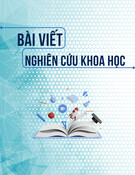
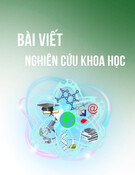






![Bộ câu hỏi trắc nghiệm Văn bản tiếng Việt [chuẩn nhất]](https://cdn.tailieu.vn/images/document/thumbnail/2025/20251127/thuynhung051106@gmail.com/135x160/24021764296609.jpg)


![Bài giảng Ngôn ngữ học đối chiếu Nguyễn Ngọc Chinh [PDF]](https://cdn.tailieu.vn/images/document/thumbnail/2025/20251101/vovu03/135x160/7471762139652.jpg)

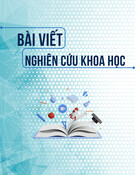
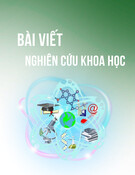

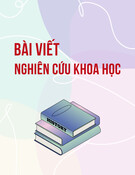
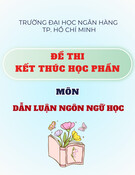

![Ngân hàng câu hỏi môn Tiếng Việt thực hành [chuẩn nhất]](https://cdn.tailieu.vn/images/document/thumbnail/2025/20251003/kimphuong1001/135x160/21861759464951.jpg)
![Bài giảng Văn học phương Tây và Mỹ Latinh [Tập hợp]](https://cdn.tailieu.vn/images/document/thumbnail/2025/20251003/kimphuong1001/135x160/31341759476045.jpg)

